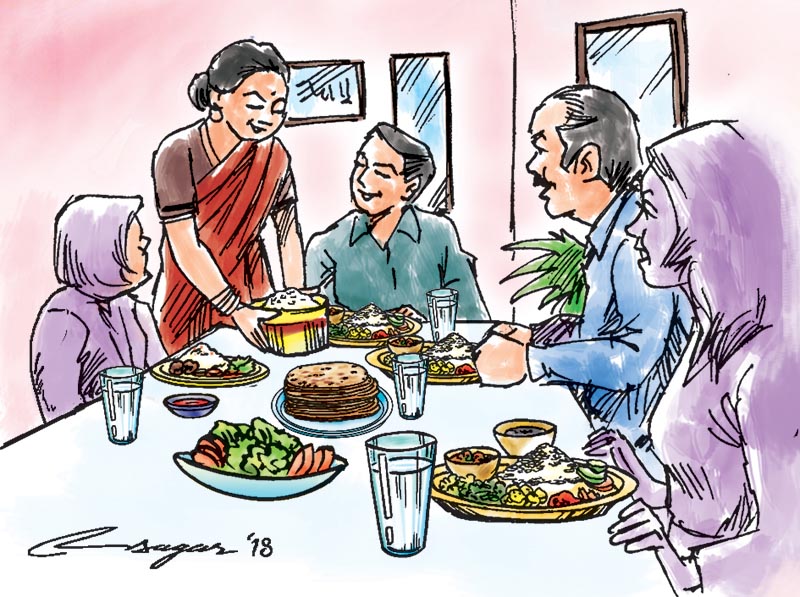Food for thought: Nutrition in kitchen
Healthy snacks for children can be made from the food items that are already available in our kitchen. Prepackaged foods and health drinks sold at exorbitant prices may look attractive and tempting, but the fact is they are low in nutrition and high in salt and sugar
Persuaded by misleading advertisements, many parents believe that pre-packaged foods carry a lot of health benefits for their children. So they buy such pre-packaged foods for their children. But the fact is such food items are low in nutrition and high in salt and sugar.
For example, packaged cereals are advertised as “healthy breakfast” but such cereals are loaded with added sugar. To preserve the cereal for a long time, preservatives and chemicals are used. This is what young children consume first in the morning.
Parents often forget that cereals and other pre-packaged foods are made with grains such as maize, rice and wheat. After adding sugar and preservatives, they are packaged in such a way that they look very attractive. They are then sold in supermarkets with high profit margins.
“Healthy drinks” that supposedly make children “taller, stronger and smarter because of their calcium and omega-33” content are false and misleading. If you look at the ingredients, you will notice that such drinks are made mostly out of wheat and barley, on which sugar, milk and chemical preservatives are added. Wheat or barley costs only Rs 50-70 for a kilogram, but thanks to clever marketing, health drinks are being sold at almost ten times more price. Not only are health drinks costlier, they are also less nutritious. My simple theory is: the more advertisement to sell a certain product, the less it should be consumed.
To provide children healthy snacks and food, parents should remember that what their grandmothers used to prepare in the kitchen. Granny’s formula still works and is the best.
Our grandmothers used to make a healthy snack from beaten rice, smashed potato, lentils and rice mixed with vegetables. Remember khichadi? It is one of the most nutritious food items as it contains most of the nutrients our body requires. Maize and soybean flour can be used for making healthy roti or chapatti. And for special occasions, we had malpuwa and khir. For daily use, our staple food used to be rice or wheat and other grains with complex carbohydrates, which were then consumed with lentils (dal), green vegetables and chatni. This diet contained proteins and all the nutrients for our body.
But these days, people are too busy to cook, and children also are quite fixated with pre-packaged foods and juice. The combination of these two factors means children are getting less nutrition and more salt and sugar. As a result, we are now seeing more young people suffering from diseases caused by bad diet and unhealthy lifestyle. A few months ago, a private school teacher requested me to visit her school and share information on junk food, packaged food and healthy food with the parents.
“Parents believe that when beaten rice or chapatti is given as snacks to their children, they may find it difficult to chew. It can also result in upset stomach,” she told me. “They want their children to consume noodles and packaged juice. I know these are not healthy, but parents barely pay heed to me.”
I went to the school with some food items – both healthy and unhealthy – and put them on a nanglo, a bamboo tray. I used pictures and illustrations to hammer home the point that children should not be given unhealthy snacks even if they demand. I also shared economic and social benefits of providing healthy food and snacks at home and schools.
Beaten rice is actually very good for health – for stomach, heart and bones. I informed them why so-called health drinks are unhealthy and how they are affecting their purse. It was surprising that parents were utterly surprised to know that what they considered healthy food was not at all healthy.
“We had a completely different idea about healthy drinks. We did not know that packaged fruit juice is so unhealthy and contains only sugar. We were giving health drinks to children because we thought they were providing them with the much-needed calcium,” they would tell me later.
I tried to make a point that whatever is available in our kitchen is best for our children’s health. All necessary macro and micronutrients are found in their most natural forms in millet, pulses, cereals, vegetables and other whole, unprocessed foods. There is no need to buy prepackaged or precooked foods that claim to have micronutrients like calcium and omega-3.
Turmeric, fenugreek and lemon to name a few not only add to our taste but are rich in nutritional values. Our staple diet is already rich in fibre that gives us the feeling of fullness and contributes to healthy digestive and metabolic system. Until children continue to get such healthy foods, parents do not need to worry about malnutrition among children.
After a few weeks, the school teacher was thankful to me that parents had stopped sending packaged juice with their children.
I have for years advocated for healthy diet. I was delighted that my brief interaction with the parents in that particular school was helpful. My understanding is if we can provide good nutrition to our children, they will grow as healthy and productive citizens of the country. I take is as my responsibility to spread the knowledge about healthy nutrition that impacts children’s mental and physical well-being.






